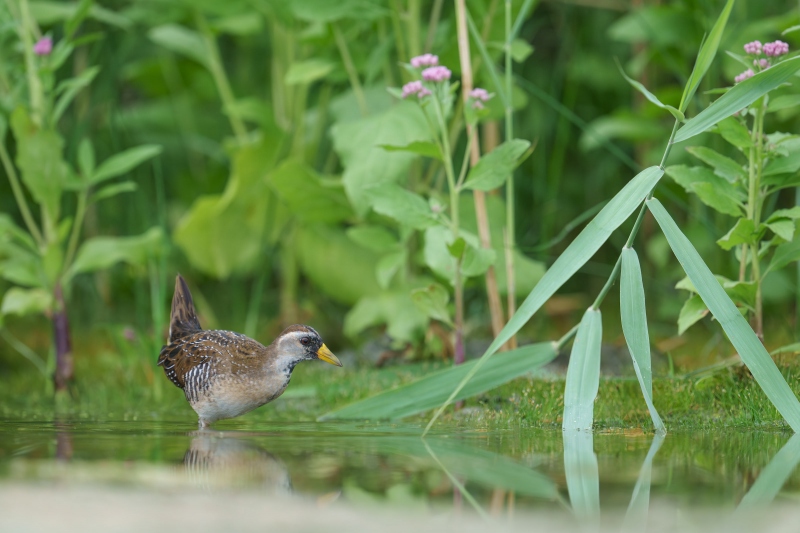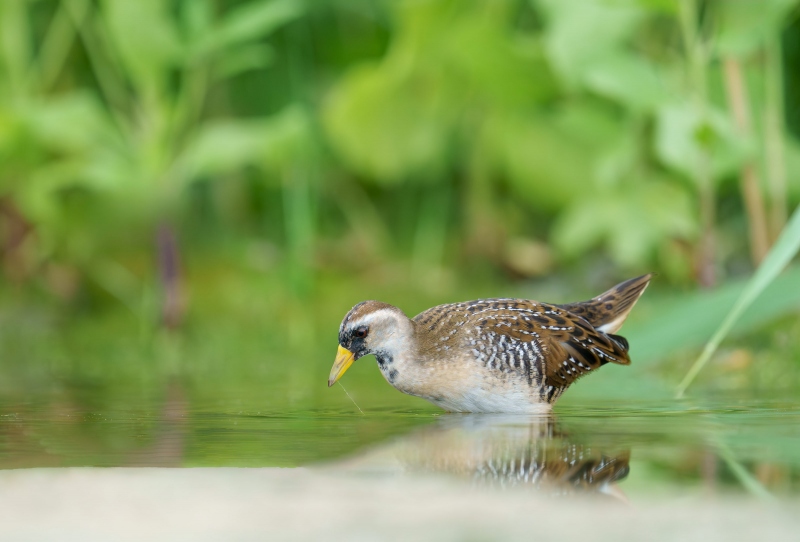Your Call
Thanks for the plethora of thoughtful comments at the last blog post. Which of today’s two featured Sora images do you like best? Please be so kind as to share your thoughts as to why you made your choice.
In Image #1, the yellowlegs was lying down flat in the water to hide from a falcon that flew overhead. I actually preferred the near B&W version to the more natural color in Image #2.
Nobody came close to answering the High Level Focusing Technique Question that accompanied Image #4. Give it a try. There are clues in the text and another one in the comments, but you will need to put your thinking cap on.
As for favorites, all but Image #2 got at least vote. One reader would have deleted Image #7. Another picked it as his favorite. Two folks loved Image #4; it was my least favorite of the seven. My top pick was #6 for its simplicity and the gorgeous background.
What’s Up?
I saw Dr. Puopolo on Tuesday afternoon to have the seven stitches removed from the base of my right thumb. The news was about what I expected, but a bit better than that. Both incisions healed perfectly. He told me that the tenderness I’ve been feeling on the inside of my right ring finger is because when the surgery is done, they stay to the left side of the nerve “for a variety of anatomical reasons” and that it typically disappears over time as the nerve calms down. I am thrilled with the results of the two operations, especially because the crushing episodes of tingling, numbness, and pain are completely gone. He is such a cool guy. I was going to confess my sins of going out to photograph twice to JBWR. When I began by saying, “I’ve been a bad patient.” He said, “Don’t tell me.” I thanked him again and we exchanged hugs.
Today is Wednesday 4 September. I set the alarm for oh-dark-hundred (3:34am) but woke at 3:00am so I got up and hit the road before 4:00am for my drive down to Lorton, VA to catch the Auto Train south late this afternoon. If all goes as expected, I should be home at about 1pm on Thursday. Whatever you are doing, I hope that you too choose to have fun and enjoy life.
Used Gear New Listngs
Sony FE 200-600mm f/5.6-6.3 G OSS Lens
BAA-friend Greg Clarkson is offering a Sony FE 200-600mm f/5.6-6.3 G OSS Lens in Like-new condition for a ridiculously low $1299.00. This lens has never been in the field. The sale includes the front and rear lens caps, the lens hood, the lens strap, the original product box, the lens case, and insured ground shipping via major courier to lower-48 US addresses only. Your item will not ship until your check clears unless other arrangements are made.
Please contact Greg via at e-mail.
The Sony 2-6 is an amazingly versatile relatively inexpensive telephoto zoom lens. It sells new for $1898.00. If you would like to get started with Sony and bird photography and cannot afford the 300mm f/2.8 GM lens then grabbing George’s pretty much new lens would be a very smart move. artie
Sony FE 90mm f/2.8 Macro G OSS Lens
Sold the first day of listing!
BAA-friend Greg Clarkson is offering a Sony FE 90mm f/2.8 Macro G OSS Lens in Like-new condition for a ridiculously low $698.00. This lens has never been in the field. The sale includes the front and rear lens caps, the lens hood, the original product box, the lens pouch, and insured ground shipping via major courier to lower-48 US addresses only.
Your item will not ship until your check clears unless other arrangements are made.
Please contact Greg via at e-mail.
Sony’s longest macro lens sells new for $998.00. If you love macro photography, grabbing Greg’s pretty much new lens right now would be the best option. artie
Get up close and personal with the 1:1 magnification ratio of the full-frame compatible Sony FE 90mm f/2.8 Macro G OSS Lens. As a G series lens, it perfectly balances sharpness and bokeh and, as a macro lens, close and controlled focusing performance is prioritized with advanced AF and intuitive handling. B& & Sony
|
|
|
This image was created on 1 September 2024 at the East Pond, Jamaica Bay Wildlife Refuge, Queens, NY. Seated on damp grass and mud behind my lowered Robus RC-5570 Vantage Series 3 Carbon Fiber Tripod/Levered-Clamp FlexShooter Pro-mounted Sony FE 600mm f/4 GM OSS lens with the Sony FE 1.4x Teleconverter, and The One, the Sony Alpha 1 Mirrorless Digital Camera.. ISO 2500. The exposure was determined by Zebras with ISO on the rear wheel: 1/1000 second at f/5.6 (wide open) in Manual mode. RawDigger showed the raw file brightness to be perfect. AWB at 11:05:37am on then very cloudy morning. Tracking: Expand Spot/AF-C with Bird-Eye/Face Detection performed perfectly. Click on the image to enjoy the high-res version. Image #1: Sora quasi-birdscape |
My First Sora?
I may have seen and/or photographed this species somewhere before, but neither the experience nor the images (???) were in any way memorable. Thus, I do not remember when, where, or even if 🙂 Thanks again to the very nice Asian lady who pointed the bird out to me as it skulked around the edge of one of the two small ponds that abutted the phragmites at the south end of the East Pond at JBWR on Saturday last.
|
|
|
This image was created on 1 September 2024 at the East Pond, Jamaica Bay Wildlife Refuge, Queens, NY. Seated on damp grass and mud behind my lowered Robus RC-5570 Vantage Series 3 Carbon Fiber Tripod/Levered-Clamp FlexShooter Pro-mounted Sony FE 600mm f/4 GM OSS lens with the Sony FE 1.4x Teleconverter, and The One, the Sony Alpha 1 Mirrorless Digital Camera.. ISO 3200. The exposure was determined by Zebras with ISO on the rear wheel: 1/800 second at f/5.6 (wide open) in Manual mode. RawDigger showed the raw file brightness to be dead solid perfect. AWB at 11:07:03am on then very cloudy morning. Tracking: Expand Spot/AF-C with Bird-Eye/Face Detection performed perfectly. Click on the image to enjoy the high-res version. Image #2: Sora in the water |
Strategy for Photographing a Rare or Uncommon Bird
When you come across a group of birders viewing a rare or uncommon species with binoculars and/or spotting scopes, you should first consider some common sense field etiquette before trying to create some images. The same is true even if they are looking at a group of commonly seen species. Walking slowly up to the group and asking where the group is from and what they are seeing is often a good start.
Unless they are very close to what they are looking at, you should put photography out of your mind at least for a few minutes. When they move along, you may begin your approach.
As I had heard that the Sora had been around the pond for at least two days and they were looking to the southeast, I knew exactly what they were looking at. Anyhoo, I walked up to the group and said “Hi” to Emme, a friendly young woman with binoculars and a field notebook, “what’s the group?” I figured it might be a local Audubon Group. “We’re the Queer Birders,” she replied.
We chatted for a while as I shared a bit of the history of the East Pond and a bit of the history of Arthur Morris/BIRDS AS ART. (Note: the two are intricately interwoven.) You can check them out here on Instagram. They have an absolute ton of great bird walks and trips in and around NYC.
After a few minutes, the group drifted off to the north. One photographer who had stayed a good distance away from the pond remained. After I finally spotted the bird (albeit with help, as above), I judged its behavior as “could-care-less.” So I flattened my tripod, crouched down a bit, walked slowly past the single photographer to the edge of the pond, got down on the ground, and worked the bird for about ten minutes until it disappeared into the reeds.
You might think that my courteous behavior was rewarded, or that I had gotten lucky.
Note that approaching a bird or a flock of birds that is being viewed by others who were there before you is 100% rude and improper. (It would be nice if the birders acted in a similar manner; often, they do not.)
Typos
With all blog posts, feel free to e-mail or to leave a comment regarding any typos or errors.
















Yes, the white water in the foreground bothers me too — on both photos. I know it would be a tight crop, but — on image #1 — I would crop the lower part out — just below the bird’s reflection. The tight crop would bother me a lot less than the white water.
Artie – Advice is like Castor Oil – easy to prescribe but hard to swallow .
Hey Raj, I have been long striving to practice what I preach so that makes giving advice with regards to field etiquette easy to do.
a
Great advice as usual. Sora’s are notoriously difficult to photograph as they tend to ensconce themselves in the reeds. It’s good to hear that the hand continues to improve.
Thanks, Adam.
I got some help and then I got lucky.
with love, artie
I don’t think I have seen that species. I like the second image a bit more than the first but I find the white foreground distracting in both. Good news on your hand.
Thanks, David,
I wam not a fan of the white water and thought about messing with it but when I try that, I wind up making a mess.
If anyone has any suggestions, please leave a comment.
with love, artie